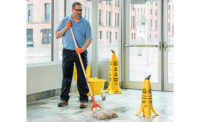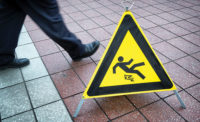 Slips, Trips and Falls
Slips, Trips and Falls
When you think of workplace falls, dramatic falls from higher elevations come to mind. Falls from higher elevations most likely result in serious or fatal injuries whereas most common, everyday falls seem minor without resulting in serious injuries. The construction industry dominates the statistics for fatal workplace falls. Construction workers are also at a greater risk of non-fatal falls due to the nature of their work.
However, during the course of a workday, anyone can slip, trip or fall anywhere under a broad range of conditions, even in the seemingly benign office setting.
Slips, trips and falls cause 10 percent of all accidental deaths and are the fourth cause of fatalities following motor vehicles, homicides, and being struck by objects or equipment.
What makes a slip, trip or fall?
Everyone has slipped, tripped, or fallen, most times without great injury. Slips and trips occur with greater frequency resulting in sprains or strains. Falls from elevations may occur infrequently but serious or fatal injuries typically result.
Falls are classified into four general categories: slips, trips, falls on stairs and falls from elevation. Slips and trips occur on the same level. Stair and elevated falls occur from one level to another.
What makes falling so hazardous?
When you fall, generally you don’t think about what is happening other than the obvious: falling off of something, falling down on the ground, or not quite falling, but losing your balance and slipping or tripping.
Generally, a fall is the result of a progression of events. There are three laws of science involved in a slip, trip or fall: friction, momentum and gravity. Friction is necessary to maintain a grip on the walking/working surface. Remove the friction and you will slip. When you encounter an object in your walking path and are thrown off balance, your momentum (the speed at which you are moving) will cause you to trip. Gravity is the force that pulls you to the ground. Once a slip or trip is in progress, the end result is usually a fall, which is only stopped by changing surface levels.
Slips and trips
Many workplace hazards lead to nonfatal fall injuries on the same level - a slip or trip. Some hazardous factors that may be common to many workplaces and contribute to a slip or trip are water on office floors, grease on shop floors, ice and snow on parking lots, uneven walking surfaces, cluttered floors, and tripping over one’s own feet.
Other factors that must be present to cause a slip are the supporting surface (floor, walkway, working surface), the opposing surface (footwear or footgear), the individual (locomotion characteristics, attentiveness, agility, disability) and the work task (lifting, reaching, moving and object).
The factors that cause a trip are a foot contacting an object or obstruction (uneven rugs, cords, blocked aisles) or too much friction between the foot and the walking surface.
Falls on stairs
Falls on stairs occur most often when someone is traveling down stairs without holding onto a handrail. Loss of traction, or friction, causes many stairway slip and fall accidents and is usually due to water or other liquid on the steps. Other forces that may lead to accidents on stairs include increased momentum, or a shift in one’s center of gravity (loss of balance).
Everyday stair usage is common so it is easy to forget that they can be hazardous. Protect yourself from injury by:
• Using handrails whenever possible and using extra caution when carrying something and can’t grip the handrail.
• Walking up and down stairs rather than running or jumping.
• Only carrying loads that you can see over.
• Promptly reporting unsafe conditions like poor lighting or clutter


